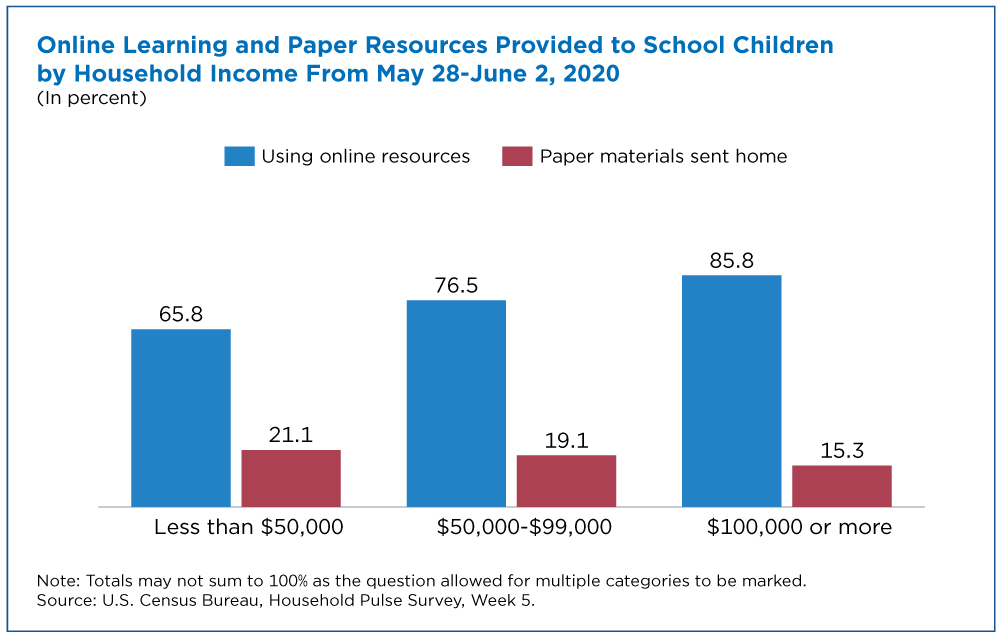Nearly 93% of Households With School-Age Children Report Some Form of Distance Learning During COVID-19
Nearly 93% of people in households with school-age children reported their children engaged in some form of “distance learning” from home but lower-income households were less likely to rely on online resources.
The COVID-19 pandemic in the spring dramatically shifted the way children were being educated. Results from the U.S. Census Bureau’s Household Pulse Survey provide a unique snapshot of just how much.
Perhaps the most salient change was closure of schools forcing students to continue their education from home.
The COVID-19 pandemic in the spring dramatically shifted the way children were being educated.
From May 28 to June 2, when many school districts across the country are normally in session, 80% of people living with children distance learning reported the children were using online resources. About 20% were using paper materials sent home by the school. (The categories overlap because respondents could select more than one category.)
Results from earlier weeks of Household Pulse Survey data were similar. Most households used online educational resources to help kids complete the school year from home.
Data from Week 5 of the Household Pulse Survey show that high-income households with children were using online resources at higher rates than those in lower-income households. (Figure 1).
For example, in households with incomes of $100,000 or more, 85.8% of people with children reported using online resources for distance learning.
By contrast, only 65.8% of people in households with incomes of less than $50,000 and 76.5% of households with incomes of $50,000-$99,999 reported that children were using online resources.
Conversely, low-income households reported higher rates of using paper materials sent home from school than high-income households do.
Households with income less than $50,000 (21.1%) and households with income from $50,000-$99,999 (19.1%) were significantly more likely to use paper materials sent home for distance learning than households with income of $100,000 or more (15.3%).
There were not significant percentage differences for the use of paper materials in households with income less than $50,000 and $50,000-$99,999. People 18 and over in households with children in school who did not report their household income (4.9% of the total sample) are excluded from Figure 1.
Digital Inequality
Patterns of digital inequality can be attributed to socioeconomic differences in the use of online resources.
Inequality in access to computers and the internet has been widely documented. Lower-income households are less likely than higher-income ones to have internet access and computer availability.
The Household Pulse Survey (Education Table 3) findings reflect that inequality. Lower-income households were less likely to report computer and internet availability for educational purposes, compared with higher-income households.
In addition to the disparities in access, low-income households may have lower levels of internet and computer proficiency, competing priorities and/or (in ordinary times) children attend schools that are not well equipped to provide online instruction.
The COVID-19 pandemic forced households and school districts to be flexible as they adapted to a changes in the delivery of education.
Household Pulse Survey results confirm that the most socioeconomically disadvantaged households do not use online educational resources for distance learning at the same rates as higher-income households.
As educators, students, and parents prepare for the next school year with some uncertainty, school administrators may examine how existing forms of educational and digital inequality interact.
What is the Household Pulse Survey?
The Census Bureau designed the Household Pulse Survey with input from other federal agency partners, including the National Center for Education Statistics and the Department of Education, to collect and disseminate data in near real time to provide vital insights into how American households are faring during the COVID-19 pandemic. We collected the first round of data for the April 23-May 5 period.
For a closer look at Census Household Pulse Survey data, see the Household Pulse Survey tables, Technical Documentation and Public Use File (PUF) microdata.
Kevin Mcelrath is a survey statistician in the Census Bureau’s Social, Economic and Housing Statistics Division.
Subscribe
Our email newsletter is sent out on the day we publish a story. Get an alert directly in your inbox to read, share and blog about our newest stories.
Contact our Public Information Office for media inquiries or interviews.
-
America Counts StoryParents Juggle Work and Child Care During PandemicAugust 18, 2020Working mothers of school-age children bore the brunt of stay-at-home orders, taking personal leave or juggling childcare while working extra hours.
-
America Counts Story2020 Census To Help School Districts Prepare for Next Era of StudentsJuly 28, 2020An accurate count of children can help communities meet the need for more educational resources, including new schools.
-
America Counts StoryThe Risks Children Face During PandemicJune 30, 2020New U.S. Census Bureau experimental Household Pulse Survey results show households with children are disproportionately affected by the COVID-19 pandemic.
-
EmploymentThe Stories Behind Census Numbers in 2025December 22, 2025A year-end review of America Counts stories on everything from families and housing to business and income.
-
Families and Living ArrangementsMore First-Time Moms Live With an Unmarried PartnerDecember 16, 2025About a quarter of all first-time mothers were cohabiting at the time of childbirth in the early 2020s. College-educated moms were more likely to be married.
-
Business and EconomyState Governments Parlay Sports Betting Into Tax WindfallDecember 10, 2025Total state-level sports betting tax revenues has increased 382% since the third quarter of 2021, when data collection began.
-
EmploymentU.S. Workforce is Aging, Especially in Some FirmsDecember 02, 2025Firms in sectors like utilities and manufacturing and states like Maine are more likely to have a high share of workers over age 55.





